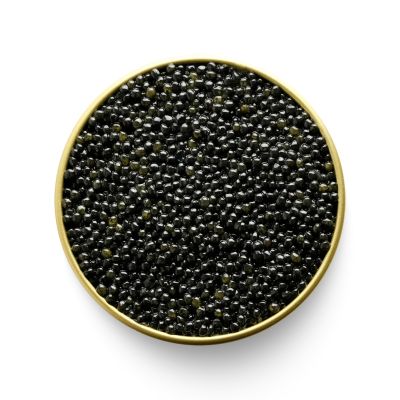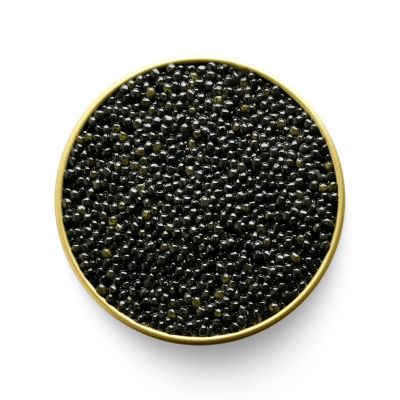Siberian Sturgeon

Siberian Sturgeon Caviar is a farmed caviar from Marky's with a unique taste that accommodates caviar experts looking to add variability to their menu. Derived from farms in Italy, France, Uruguay, and the U.S., this caviar is prominent across the world and a common substitute to the more exclusive Russian Osetra. Siberian Sturgeon Caviar has firm, medium sized beads, a rich chestnut to deep black color, and a nutty, full flavor with hints of shiitake and umami.
Siberian Sturgeon (Acipenser baerii) is a farmed caviar from Marky's with a pleasing nuttiness and hints of ocean flavor, a refined delicacy for true caviar experts.
True black caviar is harvested from members of the sturgeon family, whose historic habitats are river and sea basins from the subtropical to the subarctic zones of North America and Eurasia. The Acipenseridae family numbers 27 species, though only a select few produce this most opulent and coveted delicacy.
True black caviar is harvested from members of the sturgeon family, whose historic habitats are river and sea basins from the subtropical to the subarctic zones of North America and Eurasia. The Acipenseridae family numbers 27 species, though only a select few produce this most opulent and coveted delicacy.
Product characteristics:
Drinks: champagne brut, Blanc de Blanc or dry white wine Suggested use: Due to its upper-middle tier pricing, it would not be preferable for large scale use or to cater a large event. Because of its flavor profile it is not generally recommended to newcomers. This is a great choice to add variability to a caviar menu at a restaurant or a retail store. Siberian Sturgeon is a common substitute for Russian Osetra and is the most abundant caviar in the European and South American markets. It is greatly appreciated by caviar connoisseurs and can be enjoyed either alone or with accompaniments.
Note: Often, caviar obtained from Siberian Sturgeon is incorrectly marketed as Osetra. Depending on the country of origin you may come across French Osetra, Italian Osetra, American or Uruguayan Osetra. All are farmed from the same species (Acipenser Baerii) but in different countries. The taste and color between them will vary slightly, but it is mainly attributed to the natural color alteration of the sturgeon caviar. Of course the water and feed used in farming the sturgeons will have its influence on the taste of the end product, but this difference is very insignificant and can also be attributed to natural changes during the curing process. Another very popular product in Europe is the cross breed between Ac. Baerii and Ac. Naccarii which is commonly known as Baccarii. Be aware that this hybrid is also incorrectly marketed as pure Siberian Sturgeon or Siberian Osetra.
One of the sturgeon family's notable members is the Siberian sturgeon (Acipenser baerii), which lives in Siberian rivers, lakes, and adjacent seas. This sturgeon (sometimes known as the Siberian Osetra) is not notable among its relatives for either its size or its life span. The largest recorded fish, at 60 years old, was 2 m long and weighed around 210 kg, moderate statistics compared to wild-caught Beluga or Kaluga, which can grow to quite gargantuan size and great age.
These days such old specimens are rarely to be met with in the wild, as for several decades now human activity has drastically depleted sturgeon populations. Industrial pollution contaminating the waters of the fishes' home rivers, dams cutting off migration routes, and uncontrolled fishing and poaching have nearly wiped out many sturgeon species, leading to the imposition of strict regulations on their commercial use. The clear solution to this troubling situation, one that takes the pressure off the wild stock while continuing to supply sturgeon products to the clamorous market, is an emphasis on farm-raised fish.
Aquafarms provide an ideal environment, controlled and secure in a way the sturgeons' natural habitat is not. The fish are provided with drinking-quality water and regular and sufficient feed with strictly controlled content. Most of the fish in the worlds' aquafarms derive from fingerlings imported from the Siberian rivers, so it is nothing less than perfect truth to describe our products as 100% authentic Siberian sturgeon, with the original flavor and quality of Siberian caviar.
- Farmed-raised
- France/Italy/Uruguay/USA
- Rich brown to a deep chestnut to black color pearls
- Firm, medium size beads
- Nutty rich flavor, hints of shiitake
- Buttery, yet earthy finish with notes of sea breeze
- Best served alone on a blini or with crème fraiche
Drinks: champagne brut, Blanc de Blanc or dry white wine Suggested use: Due to its upper-middle tier pricing, it would not be preferable for large scale use or to cater a large event. Because of its flavor profile it is not generally recommended to newcomers. This is a great choice to add variability to a caviar menu at a restaurant or a retail store. Siberian Sturgeon is a common substitute for Russian Osetra and is the most abundant caviar in the European and South American markets. It is greatly appreciated by caviar connoisseurs and can be enjoyed either alone or with accompaniments.
Note: Often, caviar obtained from Siberian Sturgeon is incorrectly marketed as Osetra. Depending on the country of origin you may come across French Osetra, Italian Osetra, American or Uruguayan Osetra. All are farmed from the same species (Acipenser Baerii) but in different countries. The taste and color between them will vary slightly, but it is mainly attributed to the natural color alteration of the sturgeon caviar. Of course the water and feed used in farming the sturgeons will have its influence on the taste of the end product, but this difference is very insignificant and can also be attributed to natural changes during the curing process. Another very popular product in Europe is the cross breed between Ac. Baerii and Ac. Naccarii which is commonly known as Baccarii. Be aware that this hybrid is also incorrectly marketed as pure Siberian Sturgeon or Siberian Osetra.
One of the sturgeon family's notable members is the Siberian sturgeon (Acipenser baerii), which lives in Siberian rivers, lakes, and adjacent seas. This sturgeon (sometimes known as the Siberian Osetra) is not notable among its relatives for either its size or its life span. The largest recorded fish, at 60 years old, was 2 m long and weighed around 210 kg, moderate statistics compared to wild-caught Beluga or Kaluga, which can grow to quite gargantuan size and great age.
These days such old specimens are rarely to be met with in the wild, as for several decades now human activity has drastically depleted sturgeon populations. Industrial pollution contaminating the waters of the fishes' home rivers, dams cutting off migration routes, and uncontrolled fishing and poaching have nearly wiped out many sturgeon species, leading to the imposition of strict regulations on their commercial use. The clear solution to this troubling situation, one that takes the pressure off the wild stock while continuing to supply sturgeon products to the clamorous market, is an emphasis on farm-raised fish.
Aquafarms provide an ideal environment, controlled and secure in a way the sturgeons' natural habitat is not. The fish are provided with drinking-quality water and regular and sufficient feed with strictly controlled content. Most of the fish in the worlds' aquafarms derive from fingerlings imported from the Siberian rivers, so it is nothing less than perfect truth to describe our products as 100% authentic Siberian sturgeon, with the original flavor and quality of Siberian caviar.
We offer three different products in this category:
Siberian Sturgeon Caviar is harvested from farmed sturgeon but is easily a match for wild-caught caviar in terms of taste. The glittering medium-sized light to dark gray eggs boast a tender, melting texture, bathing your palate with its subtle, nutty flavor, refreshing with its clean sea notes.
Siberian Sturgeon Caviar France is harvested from sturgeons bred in the world famous French aquafarms. This caviar is praised by connoisseurs for the unique clean, sweet, crisp and nutty flavor of its medium-sized eggs whose pearlescent envelope ranges in color from medium gray to nearly black.
Siberian Sturgeon Caviar Italy comes from the offspring of the original Siberian Osetra fingerlings carefully raised on one of the world's largest aquafarms, located in Italy. Owing to the carefully maintained conditions and scrupulously selected natural diet, farmed Italian caviar differs little from wild-caught Siberian Osetra caviar. The traditional Malossol preparation further enhances the delicate buttery savor of this world famous caviar. Its grains are medium-sized and tender. They burst effortlessly in the mouth, releasing their incredible flavor.
The farmed Siberian Sturgeon Caviar price is already remarkably modest compared to the most expensive wild-caught Caspian caviars, but an even better bargain is our set consisting of French Siberian Sturgeon Caviar (2 oz.), Russian Original Handmade Blini (a pack of 36 pcs.), and Crème Fraîche (7-8 oz.).
Siberian Sturgeon (Acipenser Baerii) is listed as an “endangered” species on the IUCN Red List and is protected by CITES. This species experienced a 50-80% population decline over the last 60 years. Siberian Sturgeon reaches up to 6.5 feet in length and weighs up to 100 lb. Females reach sexual maturity between 11 and 22 years and males between 9 and 19, depending on the temperature of the water. Adult female fish spawns every 3-5 years and male every 2-3 years. The life span of Siberian sturgeon is 25-30 years. This species is native to all Siberian rivers which drain into the Kara, Laptev and East Siberian seas and basins of the Ob, Taz, Yenisei, Pyasina etc. They can be found in all types of freshwater benthic habitats in large rivers and lakes. Siberian Sturgeon is the only sturgeon that is widely farmed-raised in many parts of the world, including Europe, South America and China.
Siberian Sturgeon Caviar France is harvested from sturgeons bred in the world famous French aquafarms. This caviar is praised by connoisseurs for the unique clean, sweet, crisp and nutty flavor of its medium-sized eggs whose pearlescent envelope ranges in color from medium gray to nearly black.
Siberian Sturgeon Caviar Italy comes from the offspring of the original Siberian Osetra fingerlings carefully raised on one of the world's largest aquafarms, located in Italy. Owing to the carefully maintained conditions and scrupulously selected natural diet, farmed Italian caviar differs little from wild-caught Siberian Osetra caviar. The traditional Malossol preparation further enhances the delicate buttery savor of this world famous caviar. Its grains are medium-sized and tender. They burst effortlessly in the mouth, releasing their incredible flavor.
The farmed Siberian Sturgeon Caviar price is already remarkably modest compared to the most expensive wild-caught Caspian caviars, but an even better bargain is our set consisting of French Siberian Sturgeon Caviar (2 oz.), Russian Original Handmade Blini (a pack of 36 pcs.), and Crème Fraîche (7-8 oz.).
Siberian Sturgeon (Acipenser Baerii) is listed as an “endangered” species on the IUCN Red List and is protected by CITES. This species experienced a 50-80% population decline over the last 60 years. Siberian Sturgeon reaches up to 6.5 feet in length and weighs up to 100 lb. Females reach sexual maturity between 11 and 22 years and males between 9 and 19, depending on the temperature of the water. Adult female fish spawns every 3-5 years and male every 2-3 years. The life span of Siberian sturgeon is 25-30 years. This species is native to all Siberian rivers which drain into the Kara, Laptev and East Siberian seas and basins of the Ob, Taz, Yenisei, Pyasina etc. They can be found in all types of freshwater benthic habitats in large rivers and lakes. Siberian Sturgeon is the only sturgeon that is widely farmed-raised in many parts of the world, including Europe, South America and China.




